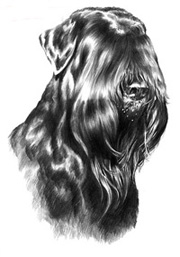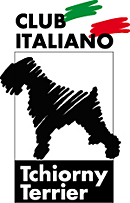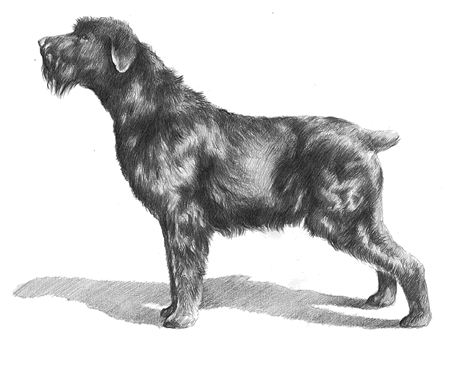
Breed

In un panorama di razze canine dalla storia millenaria, il Terrier Nero Russo si può definire l'ultimo nato, tanto è breve e recente la sua vita. Tuttavia l'impegno profuso in Russia, dagli organi governativi, per la sua creazione non solamente merita tutto il rispetto possibile, ma è anche la dimostrazione "vivente" di una razza "voluta" e "creata" avendo ben presente quali fossero le qualità che si volevano raggiungere e che si richiedevano alla razza stessa e, con tutta franchezza, si deve affermare che l'obiettivo posto è stato raggiunto in pieno e la prova è sotto gli occhi di tutti.

Uno dei capostipiti della razza / One of the pillars of the breed
HAITOR (Roi / Sotta)
Alla fine della seconda guerra mondiale la Russia, come la maggior parte delle Nazioni europee, dovette affrontare il problema della ricostruzione, necessaria per una ripresa sociale ed economica dopo i danni disastrosi prodotti dal terribile evento bellico. Di tali danni non ne soffrirono solamente le popolazioni, anche se indubbiamente il popolo pagò un prezzo altissimo (sia per numero di vittime e, sia ancora, per gli stenti disumani patiti) ma anche molte specie animali e, tra queste, in primis, proprio i cani.
La ricostruzione che ne seguì dovette affrontare vari problemi, non ultimo il saccheggio messo in atto dal popolo per sopravvivere, proprio da quel popolo messo in ginocchio da una guerra disumana, con dei massacri orribili e con delle ferite profonde, apertasi durante il conflitto e che riguardavano l'intero sistema produttivo sovietico. Il panorama che si presentò ai governanti di allora era davvero desolante sotto ogni profilo e la ricostruzione dovette superare difficoltà sociali ed economiche di enorme rilievo, penalizzando, forzatamente, il fattore umano che, di fatto, continuò a pagare un prezzo alto, in quanto a stenti e privazioni. Le conseguenze furono, come in molti altri Paesi, le razzie, i furti, messi in atto da una popolazione affamata ed affranta.
Di pari passo, quindi, sorse la necessità di selezionare dei cani capaci di svolgere la guardia alle strutture agricole ed industriali che si stavano ricreando, nonché alle stesse basi militari che furono ricostruite, e sempre più potenziate, per la difesa del territorio nazionale.
Fu proprio il Governo sovietico Centrale ad incaricare il Centro di Allevamento Nazionale "Stella Rossa" per la creazione di un cane adatto a questo tipo di attività e che, al tempo stesso, rispondesse a delle qualità di particolare rusticità, di facile adattabilità e, quindi, di facile addestrabilità e che avesse una particolare massa e sostanza, necessarie proprio per svolgere compiti di guardia e difesa nelle più disperate condizioni ambientali e climatiche che la Russia presentava.
Furono tentate, attraverso incroci tra diverse razze, varie vie, senza tuttavia ottenere all'inizio risultati soddisfacenti, capaci di rispondere alle esigenze presenti.All'inizio vennero utilizzate razze diverse, sfruttando quel poco che la guerra aveva lasciato, quali Terranova, il Rottweiler, lo Schnauzer gigante ( per la maggior parte importate dai territori occupati), nonché alcune razze autoctone, anche se non riconosciute, quali il Lupo Alsaziano e l'Alano Moscovita.
I primi soggetti, come già accennato, non diedero subito i risultati sperati. Tuttavia la strada intrapresa venne seguita, affinando, via via, le tecniche degli incroci.
Animatore di tali ricerche fu il Generale di Divisione Miedvied, considerato oggi, e giustamente, il padre della Razza, e che allora guidava un gruppo di Biologi della Scuola Centrale per l'allevamento dei cani della Polizia.
Dopo vari tentativi si scoprì che uno Schnauzer Gigante di nome Roj accoppiato con femmine di razze diverse, quali Pastori della Russia meridionale, Airedale, Rottweiler ed altri, dava sempre dei discendenti di mantello scuro, robusti, con testa lunga ed importante.La strada era quindi segnata. Si continuò ad utilizzare Roj ed i suoi discendenti, selezionandone i cuccioli migliori e più robusti, tenendo presente che le esigenze di allora non erano tanto finalizzate alla bellezza del cane, quanto piuttosto ad avere dei cani da lavoro capaci di svolgere compiti di guardia, di difesa e di cani adatti per il Corpo di Polizia, capaci, insomma di sopportare le fatiche con resistenza, con forza e, soprattutto, con grande attitudine al lavoro. In buona sostanza non ci è dato da sapere, e questo viene ammesso anche dagli stessi Russi, quali e quante razze entrarono nel gioco degli accoppiamenti e quindi contribuirono, nel concreto, a fissare i caratteri del Terrier Nero Russo. Si sa sicuramente che in essi si trova il sangue delle razze Airedale Terrier, Rottweiler, Riesenschnauzer Nero, Dobermann, tutte più o meno incrociate tra loro e con l'immissione di altre razze autoctone quali il Terranova Moscovita, qualche Levriero, i Laika ed i Cani da Pastore della Russia Meridionale.
Ovvio che successivamente si lavorò affinandone il tipo, selezionando i soggetti migliori, i più simili ad affini tra loro, sino ad arrivare poi, a fissarne "un tipo" che era pressappoco quello che attualmente vediamo nei rings delle esposizioni.
I primi Terrier Neri Russi furono presentati nel 1955 a delle rassegne ufficiale e per i risultati ottenuti il Centro Nazionale ricevette la medaglia d'oro, segno questo, allora, di enorme prestigio.
Due anni più tardi furono presentati oltre 40 Terrier Neri Russi alla Mostra Panasovietica dei cani poliziotti, i quali, subito, destarono un interesse sempre crescente tra appassionati ed allevatori, tanto che alcuni soggetti furono affidati dal Centro Nazionale a dei privati allevatori, operando così, di fatto, una collaborazione tra "pubblico" e "privato" che diede subito ulteriori effetti positivi per la razza.Di pari passo l'allevamento si comincia ad espandere, superando gli stretti confini moscoviti per svilupparsi nelle regioni del Volga, degli Urali e nelle aree settentrionali del Paese. Iniziano anche a sorgere i primi Club di razza che fissano puri i criteri e gli orientamenti per l'allevamento.
Nel 1958 viene pubblicato il primo Standard di razza accompagnato alle istruzioni per l'addestramento e l'utilizzo del Terrier Nero Russo.
Con questo si inizia, nel concreto e sempre più, a raffinare la razza, selezionandone le caratteristiche di tipicità, superando le mere esigenze utilitaristiche volute dai Centri e dalle Scuole Militari, affinandone il tipo, la costruzione ed il mantello.
Il resto è davvero storia recente, tanto da arrivare negli anni '70 a produrre oltre 4.000 esemplari, dando inizio, contemporaneamente, alle prime esportazioni verso i Paesi Scandinavi con la Finlandia in testa.
Parlando di recente proprio in Finlandia ho avuto notizie che i primi Terrier Neri arrivarono intorno al 1978, quando la Razza ancora non era ufficialmente riconosciuta dalla Federazione Cinologica Internazionale, particolare curioso, i primi soggetti adulti importati vennero pagati circa 50 dollari l'uno!
Fu solamente nel 1981 che la razza venne riconosciuta ufficialmente in Russia con la redazione del primo vero Standard ufficiale emanato dalla Direzione Generale del Ministero dell'Agricoltura. Nel frattempo alcuni soggetti avevano sconfinato anche nei Paesi che gravavano nell'orbita dell'URSS, destando subito grande interesse tra molti appassionati che ne iniziarono anche l'allevamento.Ma la consacrazione internazionale definitiva arriva nel 1983 con l'approvazione dello Standard da parte della F.C.I.. Lo standard porta il numero 327 e la razza venne inclusa, più che altro per il nome che porta, nel III Gruppo, tra gli altri Terriers. Infatti, a più riprese e giustamente, il Kennel Club Russo, sorto dopo la perestroika, chiese alla stessa F.C.I. ed ottenne l'inclusione della razza nel II Gruppo privilegiando giustamente le caratteristiche di cane di lavoro, premiando di fatto quanti, oltre 40 anni prima lo vollero creare, partendo proprio da quello che si aspettavano sotto il profilo del lavoro piuttosto che da quello esteriore. Per questo si può ben dire che il risultato finale ha veramente del prodigioso.
Credo proprio che in nessun altro caso della lunga storia delle razze canine, nessuna altra razza venne voluta, fu creata e fissata in un così breve lasso di tempo e soprattutto con un risultato di qualità e popolarità così rapido tanto da essere definita "la perla nera russa"! Oggi i Terriers Neri Russi sono diffusi in tutti i Continenti ed il loro interesse è un continuo crescendo.Le loro qualità, in Patria ed all'estero, hanno raggiunto dei livelli di assoluto rispetto, tanto da vederli vincere spesso non solamente dei raggruppamenti, ma anche dei Best in Show.
Il problema che ora si pone è quello di mantenerlo ai livelli che ha nella Madre Patria, ai livelli voluti dagli Amici Russi.Lo sviluppo che ha raggiunto e che sempre più ottiene, può portare ad un decadimento delle sue alte qualità producendo più per il mercato piuttosto che mirare ad una rigorosa conservazione e miglioramento del tipo e delle qualità naturali previste dallo Standard. E' questo il prezzo pagato spesso anche da altre razze che hanno avuto uno sviluppo troppo rapido e che ha portato l'allevamento più verso il mercato piuttosto che al rispetto dei canoni fissati dagli Standards.Speriamo che ciò avvenga anche per il Terrier Nero Russo, anche se, giudicando nei diversi continenti, ho potuto constatare che alcuni soggetti presentano delle preoccupanti deviazioni sia per il tipo e sia, ancora, sotto il profilo caratteriale. L'ingresso della Russia nella Federazione Cinologica Internazionale rappresenta, sotto questo profilo, una maggiore garanzia per la tutela della razza. Sempre più, infatti, i Terriers Neri vengono giudicati nelle più importanti Esposizioni da Colleghi Specialisti Russi e ciò rappresenta una garanzia assoluta per un armonico sviluppo rispettoso dei canoni fissati dallo Standard.
At the end of WWII, Russia, like the majority of European countries, had to face the problem of re-building. This was necessary in order to favour social and economic re-growth following the disastrous results of those terrible war years. The damages were sustained not only by the population, although undoubtedly the people were those most affected (as regards number of victims and inhumane conditions), but many animal species were also affected, and foremost among these, were dogs.
The re-building that followed had to deal with many problems. One of the most important was that the population was forced to plunder in order to survive. The people had been brought to their knees by an inhumane war, they had experienced horrendous massacres, and were deeply wounded by the conflict which involved the entire Soviet productive system.The view offered to the governors of the time was bleak. Re-building had to overcome enormous social and economic problems, penalising the human aspect. It was the people that continued to experience hardship and deprivation. The results were the same in many countries, plunder and theft by a devastated population going hungry.
At the same time there was the need to select dogs able to effectively guard budding agricultural and industrial premises, as well as military bases undergoing re-construction, which were to defend the national territory.
It was the same Soviet Central Government that established the "Red Star" National Breeding Centre for the creation of a dog having those types of characteristics, and capable of being hardy, easily adaptable, and therefore easy to train. This dog had to be of a specific mass and size, suitable for guard work in the widest range of environmental and weather conditions present in Russia.
Various attempts were made at cross-breeding various species, initially without achieving satisfactory results that fulfilled the necessary requirements.
Different breeds were used at the beginning, using the few examples that had survived the war, breeds such as Newfoundlands, Rottweilers, Giant Schnauzers (mostly imported from occupied territories), as well as a few native, non recognised breeds such as Alsatian wolfhounds and Moscow Great Danes.
As already mentioned the first examples were not as successful as was hoped, nonetheless this path was followed and cross-breeding techniques were refined along the way.
Division General Miedvied was a perpetrator of this research, and is today rightly considered to be the father of the Breed. At the time he headed a group of Biologists at the Central Breeding School for Police dogs.
Various attempts were made, and it was discovered that a Giant Schnauzer named Roj mated to females of various breeds such as southern Russian Sheep dogs, Airedales, Rottweillers and others, always produced descendants with a dark coat, strong, and with an elongated, important head.
The way had been shown. Roj and his descendants continued to be used, choosing from among the strongest and the best puppies, and ever present was the requirement that at that time what was important was not the creation of beautiful dogs, but rather working dogs that were able to guard and defend, and dogs suitable for Police work. They had to be able to withstand hardships, be strong and above all have a great aptitude to work.
In actual fact we do not know, and nor do the Russians themselves know, which breeds and how many were used in the cross-breeding that contributed to the characteristics of the Russian Black Terrier. We do know that the dogs contain genes from Airedale Terriers, Rottweilers, Black Riesenschnauzers, Dobermanns, all more or less cross-bred, as well as other native breeds such as the Moscow Newfoundland, some wolfhounds, Laikas and Southern Russian Sheep Dogs.
Obviously, as time went on, the types were scaled down and the best dogs chosen, dogs that were similar and resembled one another, to a point where one "type" was set, which was more or less the one we are currently seeing in the show rings.
The first Russian Black Terriers were presented in 1955, and the results obtained in official events as well as the outcome of the breeding earned the National Centre a gold medal. This was an extremely prestigious award at the time.
Two years later over 40 Russian Black Terriers were shown at the PanSoviet Show for Police Dogs. They immediately captured the attention of breeders and enthusiasts alike, and a few dogs were even lent from the National Centre to private breeders, beginning, in this way, a collaboration between "state" and "private" enterprise, that immediately led to a positive outcome for the breed.
At the same time the kennels began to expand, breaking out from the confines of Moscow, and moving into the Volga and Urals areas and the northern parts of the country. The first Breed Clubs were also starting to emerge, that set the breeding criteria and direction.
In 1958 the first Breeding Standard was published together with breeding and use instructions for the Russian Black Terrier.
This led to the establishment of the breed, and refined it, selecting the typical characteristics, overcoming the requirements of simple usefulness set by the Centres and Military Academies, and honing the type, build and coat.
The rest, as they say, is history. In the '70's there were over 4.000 dogs, this consequently permitted the first exports to Scandinavian countries, with Finland at the forefront. The first Black Terriers arrived in Finland around 1978, when the breed was still not officially recognised by the International Kennel Federation, and an interesting fact is that the first adult dogs to be imported were paid about 50 dollars each!
It was only in 1981 that the breed was officially recognised in Russia, where the first real official standard was drawn up by the General Directorate of the Ministry of Agriculture.
Meanwhile a few of the dogs had also emigrated to countries within the USSR sphere of influence, immediately capturing the attention of many enthusiasts who began breeding them.
Final international acceptance was gained in 1983 with the approval of the Standard by the "F.C.I" (I.K.F.).
The standard bears the number 327 and the breed is included, more for its name, in Group 3, among the other Terrier groups.
Indeed, the Russian Kennel Club, which was established following "perestroika", on numerous occasions requested that the "F.C.I." insert the breed into Group 2. This justified request was granted, and this placing now favours the dog's characteristics as a work dog, justifying those who 40 years ago created this breed highlighting what were then work characteristics rather than appearance. Thus we can say that the final outcome has been quite extraordinary.
One can safely say that in no other case in the long history of dog breeds has another breed been wanted, created and established in so short a period of time, and above all with such speedy results concerning quality and popularity, to warrant being called "the black pearl of Russia"!.
Today Russian Black Terriers are widespread in all the continents and interest in this breed continues to grow.
Their quality in their country of origin and abroad has reached such noteworthy levels that they often win not only their own group category, but also the Best of Show categories.
The problem we now face is that of keeping the dogs at the same level as in their homeland, those levels demanded by the Russians.
The levels of development that have been reached and which are continuing could lead to a slide in quality, producing more for the market rather than aiming at a strict adherence and improvement of the type and those natural qualities as set out in the Standard. This is the price often paid by other breeds that have undergone a development that has been too fast, leading to breeding aimed more at the market than within the regulations set by the Standards.
We hope that this will not be case with the Russian Black Terrier, although we can state that in many countries and on many continents there are a few dogs that exhibit worrying deviations both in type and character.
The admittance of Russia to the International Kennel Federation will offer the best guarantee for safeguarding the breed. The Black Terrier is judged more and more often by Russian specialist judges in the most important Shows, and this represents an absolute guarantee for a harmonious development under the guidelines set by the Standard.

